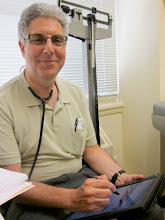 The next few weeks are going to be filled with WIRED fun. I started off the month of March with Sigma Care, the new electronic medical record, (EMR), for one of my nursing homes. Digitizing the nursing home has been a long-term project. I have used spreadsheets and relational data base programs to organize my nursing home lists and to print forms to use for charting. Finally, I have a non-hospital EMR to play with.
The next few weeks are going to be filled with WIRED fun. I started off the month of March with Sigma Care, the new electronic medical record, (EMR), for one of my nursing homes. Digitizing the nursing home has been a long-term project. I have used spreadsheets and relational data base programs to organize my nursing home lists and to print forms to use for charting. Finally, I have a non-hospital EMR to play with.For the first time at this nursing home, I can print a list of my patients sorted by nursing unit. I can also see my patient's medication list without looking through the medication administration record, (MAR). Writing orders and labs on the computer is a bit hard to do this first week, because I'm not used to it, but being able to see all my orders on a screen without having to read bad handwriting in the MAR has been worth it.
This evening I had to verify orders for one of my partner's patients who was readmitted. I brought up the list on my Mac and was able to find two medications that were missing from the hospital discharge medication list. The nurse was having trouble pronouncing the names of some of the drugs, (a common occurrence). This was not a problem as I could figure out what she was saying because I had the list in front of me.
I also was able to see the list on my iPhone by using the Opera browser. I heard that you can see the lists on Android devices as well. I will be trying out this EMR on several devices including the iPad and the Xoom during the next few weeks and will have more to say on hand-held devices soon.
This week I will be trained on Dragon speech recognition software by my hospital so I should have some interesting news to report next time.



